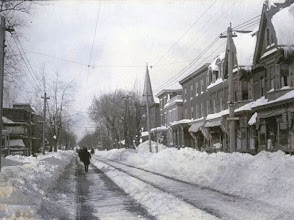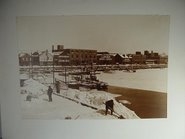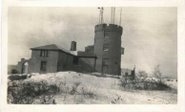PDO - November '06
Woo-hoo! -0.22
The last five months have also been negative but the inter-decadal oscillation of the PDO is revealed by a five-year running average of values for October - March. The cool-season average going into this winter was weakly negative @ -0.15 driven mainly by two month/s of strongly cold values during the fall of '05.

5-yr MAVG and Yearly PDO
Charting the PDO since 1915 produces a 'smooth' sinusoidal wave where the inter-decadal variability is readily apparent. Apparent that is...until the late '80s / early '90s when the pattern becomes fragmented.
The five-year moving average going into this winter was warm (0.30) as was the preceding year (0.33). The five years prior ('00 - '04) it was negative or just below zero. Going back a few more years further reveals the same weak back-n-forth signature; however, the forays into negative territory were less than one sigma of the mean during the current period...which began in 1980... when values are generally positive.
Despite the recent inter-annual variability...the five-year running average shows we/re in the positive phase of the oscillation.
The historical record of teleconnection indices varies from 1876 for the SOI to 1950 for many others such as QBO...MEI...AO...and NAO. The snowfall period of record varies too...so when evaluating analog years...1950 is usually the earliest.
Whether evaluating the current year/s PDO against the full period beginning in 1900 or only considering years since 1950...the best analog year is 1960...as it was last month.
The problem with '60 is there was a neutral ENSO that winter. All of the Top Five PDO analog years occurred during neutral or cold ENSOs.
So where/s all this analysis take us? Does it reveal anything about the coming winter?
Maybe. Probably not.
Negative phase is correlated with above normal heights over the SE...which is a characteristic of La Nina.
Positive phase finds warm water collecting along the west coast...low SLP over the Aleutian Is. and cold SSTA between 20°N and 60°N. These synoptic features would favor a LW pattern of ridge-W implying +PNA and would complement the fx of +ENSO. +PDO is positively correlated with +ENSO.
Charting the PDO since 1915 produces a 'smooth' sinusoidal wave where the inter-decadal variability is readily apparent. Apparent that is...until the late '80s / early '90s when the pattern becomes fragmented.
The five-year moving average going into this winter was warm (0.30) as was the preceding year (0.33). The five years prior ('00 - '04) it was negative or just below zero. Going back a few more years further reveals the same weak back-n-forth signature; however, the forays into negative territory were less than one sigma of the mean during the current period...which began in 1980... when values are generally positive.
Despite the recent inter-annual variability...the five-year running average shows we/re in the positive phase of the oscillation.
The historical record of teleconnection indices varies from 1876 for the SOI to 1950 for many others such as QBO...MEI...AO...and NAO. The snowfall period of record varies too...so when evaluating analog years...1950 is usually the earliest.
Whether evaluating the current year/s PDO against the full period beginning in 1900 or only considering years since 1950...the best analog year is 1960...as it was last month.
The problem with '60 is there was a neutral ENSO that winter. All of the Top Five PDO analog years occurred during neutral or cold ENSOs.
So where/s all this analysis take us? Does it reveal anything about the coming winter?
Maybe. Probably not.
Negative phase is correlated with above normal heights over the SE...which is a characteristic of La Nina.
Positive phase finds warm water collecting along the west coast...low SLP over the Aleutian Is. and cold SSTA between 20°N and 60°N. These synoptic features would favor a LW pattern of ridge-W implying +PNA and would complement the fx of +ENSO. +PDO is positively correlated with +ENSO.

5H Z correlations to +PDO similar to +PNA
Temperature and Precipitation correlations to +PDO
show cooler and wetter in the E

SST observed, weekly SSTA, monthly SSTA, and seasonal SSTA
Click to animate. Loop speed = 3 sec / frame
So, where are we so far?
+ENSO - check
+PNA - still waiting
Warm water along west coast - not so much
PDO as a leading indicator seems to be a wash this year. No signature features and all the best analog years are conflicted with the current ENSO phase.
Most graphics and background information from Mantua.
Warm water along west coast - not so much
PDO as a leading indicator seems to be a wash this year. No signature features and all the best analog years are conflicted with the current ENSO phase.
Most graphics and background information from Mantua.
























No comments:
Post a Comment